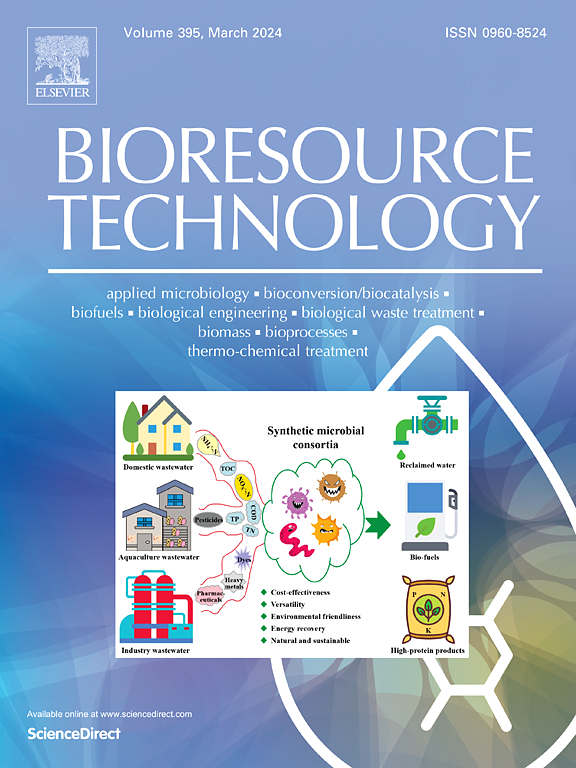异养硝化和好氧反硝化菌群的富集:微生物群落演替和脱氮特征及机制。
IF 9.7
1区 环境科学与生态学
Q1 AGRICULTURAL ENGINEERING
引用次数: 0
摘要
本研究从垃圾渗滤液中培养了一个细菌联合体(S60),该联合体具有有效的异养硝化和好氧反硝化(HN-AD)特性。在好氧条件下,S60财团以NH4+-N作为唯一氮源或与NO2——N和NO3——N联合使用时,NH4+-N的去除率达到100% %。以乙酸钠为碳源,pH为7.0 ~ 8.0,溶解氧浓度为4.0 ~ 5.0 mg/L, C/N为10时,HN-AD性能最佳。此外,在S60群体中还发现了功能基因(amoA、hao、napA、nirK、nirS、nosZ)、羟胺氧化酶、硝酸盐还原酶和亚硝酸盐还原酶。从这些发现,划定的HN-AD途径有两个:NH4 + - N → 回复: → NO2——N → NO3——N → NO2——N → 没有 → 一氧化二氮 → N2和NH4 + - N → 回复: → 一氧化二氮 → N2。S60菌群的宏基因组分簇分析揭示了盐单胞菌、Zobellella、Stutzerimonas、Marinobacter和Pannonibacter中异化硝酸盐还原和反硝化的完整途径。这些发现为HN-AD细菌在不同氮源环境下的应用及其协同脱氮提供了新的见解。本文章由计算机程序翻译,如有差异,请以英文原文为准。

Enrichment of a heterotrophic nitrifying and aerobic denitrifying bacterial consortium: Microbial community succession and nitrogen removal characteristics and mechanisms
This study cultivated a bacterial consortium (S60) from landfill leachate that exhibited effective heterotrophic nitrification and aerobic denitrification (HN-AD) properties. Under aerobic conditions, the removal of NH4+-N reached 100 % when the S60 consortium utilised NH4+-N either as the sole nitrogen source or in combination with NO2–-N and NO3–-N. Optimal HN-AD performance was achieved with sodium acetate as a carbon source and a pH of 7.0–8.0, dissolved oxygen concentration of 4.0–5.0 mg/L, and a C/N ratio of 10. Furthermore, the presence of functional genes (amoA, hao, napA, nirK, nirS, nosZ), hydroxylamine oxidase, nitrate reductase, and nitrite reductase was confirmed in the S60 consortium. Drawing from these findings, two HN-AD pathways were delineated: NH4+-N → NH2OH → NO2–-N → NO3–-N → NO2–-N → NO → N2O → N2 and NH4+-N → NH2OH → N2O → N2. Metagenomic binning analysis of the S60 consortium uncovered complete pathways for dissimilatory nitrate reduction and denitrification within Halomonas, Zobellella, Stutzerimonas, Marinobacter, and Pannonibacter. These findings offer new insights into the application of HN-AD bacteria and their collaborative nitrogen removal in environments with varying nitrogen sources.
求助全文
通过发布文献求助,成功后即可免费获取论文全文。
去求助
来源期刊

Bioresource Technology
工程技术-能源与燃料
CiteScore
20.80
自引率
19.30%
发文量
2013
审稿时长
12 days
期刊介绍:
Bioresource Technology publishes original articles, review articles, case studies, and short communications covering the fundamentals, applications, and management of bioresource technology. The journal seeks to advance and disseminate knowledge across various areas related to biomass, biological waste treatment, bioenergy, biotransformations, bioresource systems analysis, and associated conversion or production technologies.
Topics include:
• Biofuels: liquid and gaseous biofuels production, modeling and economics
• Bioprocesses and bioproducts: biocatalysis and fermentations
• Biomass and feedstocks utilization: bioconversion of agro-industrial residues
• Environmental protection: biological waste treatment
• Thermochemical conversion of biomass: combustion, pyrolysis, gasification, catalysis.
 求助内容:
求助内容: 应助结果提醒方式:
应助结果提醒方式:


